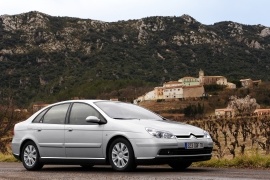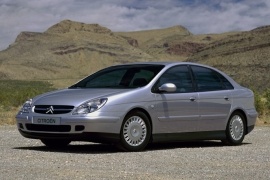CITROEN C5 Liftback Models/Series Timeline, Specifications & Photos
First production year: 2001
Engines: Diesel, Gasoline
Body style: Hatchback
Citroen refreshed the first C5 generation in 2004, and the changes went further than just new wheels and paints for the bodywork.
Citroen prepared itself to comply with the following Euro 4 emission standards and refreshed the C5 lineup. Apart from a new engine, the carmaker introduced a new generation of the Hydractive technology that made the Citroens so special on the market with their smooth, comfortable rides.
For starters, the car was longer due to the thicker bumpers. At the front, there was a new apron and slatted grille flanked by new round fog lights. The carmaker made the badge bigger and extended on the hood with chromed slats. New, boomerang-shaped headlights replaced the older, tear-shaped ones and were available with an option for swiveling directional system. Unlike other carmakers, Citroen heavily worked at the back of the car and changed the rear quarter panels, the bumper, and tailgate to accommodate the new L-shaped taillights.
Inside, the carmaker worked more on details. The instrument panel received silver dials for a sportier look. Also, on the center stack, the carmaker introduced an option for a more powerful infotainment unit.
But the most significant changes were under the hood, where the engine lineup was enhanced by a new, 1.6-liter turbo-diesel, which offered the same power as the previously used base version of the 2.0-liter HDI.
The expansion of the midsize car market in the late '90s convinced French manufacturer Citroen to launch the C5 range in 2001. It was built to replace two vehicles from Citroen's range: the Xantia and the bigger XM. Big enough to host five adults and a big trunk, it offered 8 engine variants developing between 90 hp and 207 hp. It was only front-wheel-drive and its main advantage was the air suspension.
The big headlights were an important upgrade over the previous midsize station wagon, the Xantia Break, which had rectangular small front lights. Another important improvement was on the suspension side, with the introduction of the Hydractive III system. This was able to hold the car's ground clearance at the same level regardless how much weight was loaded into the vehicle. It wasn't exported in the North American market.
The biggest engine available was a 3.0-liter V6 gasoline, mated to a standard 6-speed automatic gearbox. Other versions had manual transmissions with 5 or 6 speeds. The diesel range was also important in that period, and engines with a displacement between 1.6 liters and 2.2 liters were installed with power ranging between 90 hp and 170 hp.
A major facelift was made in 2004 when the option of directional headlights was introduced. Citroen was the first mainstream car manufacturer in the world to install adaptive headlights in a car, in the original, 1955 Citroen DS.

